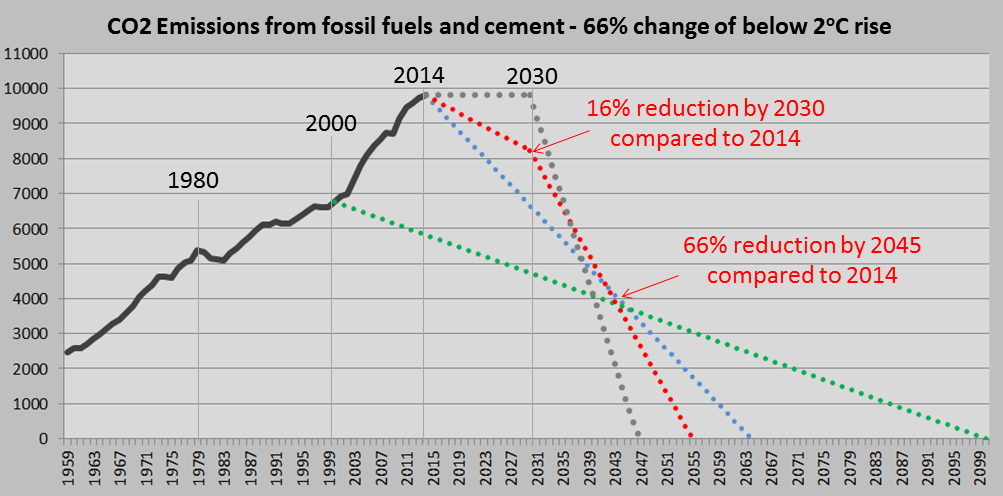The COP21 Paris Agreement: Diplomatic triumph, self-applause … and the carbon budget

2015
The COP21 ‘Paris Agreement’ (31 p), backed by 196 countries, emphasizes the urgent need to address the greenhouse gas emission gap between the aggregate effect of the 187 intended nationally defined contributions (INDCs/pledges) and the “aggregate emission pathways consistent with holding the increase in the global average temperature to well below 2°C above preindustrial levels and pursuing efforts to limit the temperature increase to 1.5°C”. This feverish understatement about the emission gab is clarified in the ‘Synthesis report (UN)’ on the aggregate effect of the pledges. The report says that the aggregate effect of the submitted pledges (INDCs) will bring the global cumulative CO2 Emissions up to around 72%–77% of the remaining carbon budget by 2030 (emitting 100% will leave the planet with 66% change of a temperature rise of less than 2°C). In other words: If the pledges are fulfilled perfectly, then three quarters of the remaining carbon budget will be used within 15 years … and thereafter emissions will have to dive deeply to zero before 2040. The critical situation is envisioned graphically below.
The diagram shows the world’s CO2 Emissions from fossil fuels and cement between 1959 and 2014 (the black line), in million tons of carbon. Note that the included emissions are only a dominant part of all greenhouse gases covered by the submitted pledges (read ‘more’). The stippled lines show four reduction scenarios within the below 2°C carbon budget (with 66% change):
- The green stippled line shows an outdated linear reduction rate starting 2000 and reaching zero around 2100.
- The blue stippled line shows a linear reduction rate starting 2014 and reaching zero around 2063.
- The red stippled line shows a reduction rate starting 2014, with 16% reduction by 2030, and reaching zero around 2055 (with 66% reduction by 2045).
- The grey stippled line shows unchanged emissions between 2014 and 2030, and reaching zero around 2047.
Note that even the last scenario (the grey) is far more optimistic on the period 2014-2030, than the 187 pledges delivers. More comments below the diagram.
The red scenario represent the most super-optimistic, sensational development one can possibly hope for after the Paris Agreement. Since the agreement is essentially an ambitious global warming target (less than 2°C and pursuing 1.5°C) and a complicated standardized framework … without any committing pathways to the target – then the super-optimism will have to be fed by the trust in parallel happenings such as:
- Divestments from fossil fuels.
- Stranded fossil fuel assets.
- Improved renewable energy technologies, batteries etc.
- Changed lifestyles.
- Accelerating greenhouse gas reduction race between countries and companies.
- Embargoes, boycotts and shitstorms against most poluting countries and companies.
- Civil disobedience.
- Legal sanctions.
The mismatch between aims and means in the Paris Agreement taken into account, the euphoria and self-applause at the end of COP21 is somewhat misplaced.
Read also the unfccc ‘Lima-Paris Action Agenda‘ and the article ‘Giving up on-future generations is real (about COP-submissions 2015)‘.
.
The COP21 ‘Paris Agreement’.
COP21 pledges: ‘Intended Nationally Defined Contributions‘ (INDCs).
The ‘Synthesis report (UN)’ on the aggregate effect of the pledges.
Data on global carbon emissions is from Carbon Budget Project: ‘http://cdiac.ornl.gov/GCP/‘.
Related websites and articles:
‘http://climateparis.org/‘
‘http://www.carbonbrief.org/carbon-briefing-making-sense-of-the-ipccs-new-carbon-budget‘
‘http://www.monbiot.com/2015/12/15/cop-out/‘
‘http://www.theguardian.com/environment/true-north/2015/dec/15/claim-no-easy-victories-paris-was-a-failure-but-a-climate-justice-movement-is-rising‘
‘http://globalchange.mit.edu/research/publications/other/special/2015Outlook‘
‘http://www.theguardian.com/environment/2015/dec/12/james-hansen-climate-change-paris-talks-fraud‘
Image (Titanic collage … half of the below 2°C carbon budget in 1980 are now used) by Claus Andersen, 2015.
Comments are closed.
